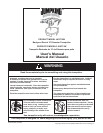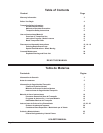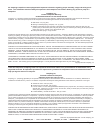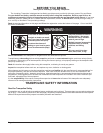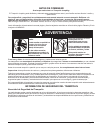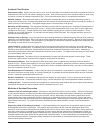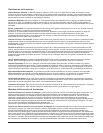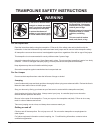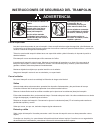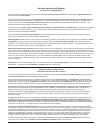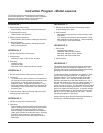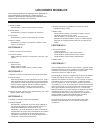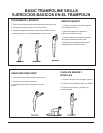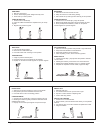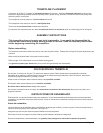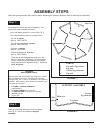
Page 6
Accident Classification
Somersaults (flips): Landing on your head or neck, even in the middle of a trampoline mat (bed), increases the risk of a
broken back or neck, which can result in paralysis or death. Such events can occur when a jumper makes an error trying
to perform a forward or backward somersault (flip). Do not do somersaults (flips) on this backyard trampoline.
Multiple Jumpers: More than one jumper on the trampoline increases the chance of someone becoming injured by
losing control of their jump. Jumpers may collide with one another, fall off the trampoline, fall on or through the springs, or
land incorrectly on the mat (bed). The lightest weight jumper is the most likely to be injured.
Mounting and Dismounting: The trampoline mat (bed) is several feet from ground level. Jumping off the trampoline to
the ground or any other surface may result in injury. Jumping onto the trampoline from a roof, deck, or other object also
represents a risk of injury. Smaller children may need assistance getting up on or down from the trampoline. Climb
carefully on and off the trampoline. Do not step onto the springs or the frame pad. Do not grasp the frame pad to pull
yourself onto the trampoline.
Striking Frame or Springs: Injury may result from encountering the frame or falling through the springs while jumping or
getting on or off the trampoline. Stay in the center of the trampoline mat (bed) when jumping. Be sure to keep the frame
pad in place to cover the frame. The frame pad is not designed nor intended to support the weight of the trampoline user.
Do not step or jump directly onto the frame pad.
Loss of Control: Jumpers who lose control of their jump may land on the mat (bed) incorrectly, land on the frame or
springs, or fall off the trampoline. A controlled jump is one where the landing is in the same spot as the take off. Before
learning a more difficult maneuver, the preceding one should be performed consistently under control. Attempting a
maneuver beyond present skill levels increases the chance of loss of control. To regain control and stop your jump, bend
your knees sharply when you land.
Alcohol or Drug Use: The chance of injury increases when a jumper has consumed alcohol or taken drugs. These
substances impair a person's reaction time, judgment, and physical coordination.
Encountering Objects: Use of a trampoline while other people, pets, or objects are underneath it will increase the
chance of injury. Jumping while holding or having an object on the trampoline, particularly one that is sharp or breakable,
will increase the chance of injury. Placing a trampoline too close to overhead electrical wires, tree limbs, or other obstruc-
tions can increase the chance of injury.
Poor Maintenance of Trampoline: Jumpers may be injured if a trampoline is used when it is in poor condition. A torn
mat (bed), bent frame, broken spring, or a missing frame pad, for example should be replaced before anyone is allowed
to jump. Inspect the trampoline before each use.
Weather Conditions: A wet trampoline mat (bed) is too slippery for safe jumping. Gusty or severe winds can cause
jumpers to lose control. To reduce the chance of injury, use the trampoline only under appropriate weather conditions.
Limiting Access: To prevent
access to the trampoline by unsupervised small children the access ladder should always
be removed and stored in a secure location when the trampoline is not in use.
Methods of Accident Prevention
Jumper's Role in Preventing Accidents: Education on the part of the user is a must for safety. Users must first learn
a, low controlled bounce and then learn the basic landing positions and combinations before proceeding to intermediate
skills. Jumpers must understand why they have to master "control" before they can start thinking about other moves.
Understanding the proper progression of skills in jumping on a trampoline must be the first lesson. Review the user's
manual to learn about the basic techniques for using the trampoline. Follow the rules on the placard that presents Tram-
poline Safety Instructions. For further information or additional instructional materials, contact a certified trampoline
instructor.
Supervisors Role in Preventing Accidents: It is the responsibility of the supervisors of trampoline users to provide
knowledgeable and mature supervision. They need to know and enforce all the rules and warnings set forth in this
manual in order to minimize the likelihood of accidents and injuries and to inform users of these rules. During periods of
time when supervision is unavailable or inadequate, this may require that the trampoline be disassembled, placed in a
secure area, or otherwise secured against unauthorized use. Another option which may be considered is covering the
trampoline with a heavy tarp, which can be secured with locks and chains. It is the responsibility of the supervisor to be
sure that the placard with the Trampoline Safety Instructions is kept posted on the trampoline and that jumpers are
informed about these instructions.



